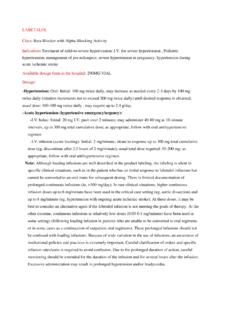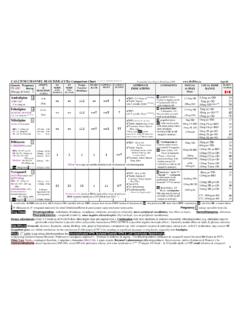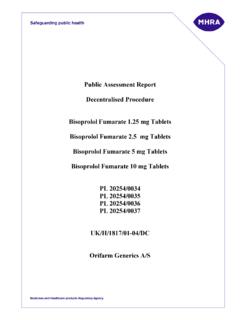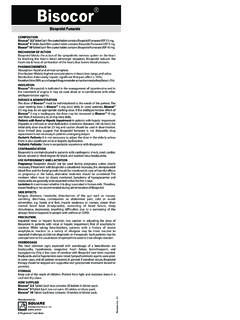Transcription of ZAPRIL 1. Product Name - Medsafe
1 Page 1 of 14 NEW ZEALAND DATA SHEETZAPRIL1. Product NameZAPRIL, mg, mg, 5 mg, film coated Qualitative and Quantitative CompositionEach ZAPRIL mg, 2 mg or 5 mg of cilazapril as cilazapril monohydrate. ZAPRIL tablets contain lactose. For the full list of excipients, see section Pharmaceutical FormZAPRIL mg tablets are white, oval-shaped, biconvex, film coated tablets, with CI scoreline on one side and G on the other side. Each tablet contains mg mg tablets are pinkish brown, oval-shaped, biconvex, film coated tablets, with CI scoreline on one side and G on the other side. Each tablet contains mg 5 mg tablets are reddish brown, oval-shaped, biconvex, film coated tablets, with CI scoreline 5 on one side and G on the other side. Each tablet contains 5 mg tablet can be divided into equal Clinical Therapeutic indicationsZAPRIL is indicated in the treatment of all grades of essential hypertension and renovascular hypertension.
2 ZAPRIL is also indicated in the treatment of congestive heart failure as an adjunctive therapy with digitalis and/or Dose and method of administrationDoseEssential hypertensionThe recommended initial dosage is half a tablet once a day. Blood pressure should be assessed, and dosage adjusted individually in accordance with the blood pressure response. The usual dose range of cilazapril is to 5 mg once blood pressure is not adequately controlled with 5 mg cilazapril once daily, a low dose of a non-potassium-sparing diuretic may be administered concomitantly to enhance the antihypertensive 2 of 14 Renovascular hypertensionTreatment with cilazapril should be initiated with a dose of mg or mg once daily since these patients may experience more pronounced decreases in blood pressure in response to ACE inhibitors than patients with essential maintenance dose should be adjusted patients receiving diureticsThe diuretic should be discontinued 2 to 3 days before beginning therapy with cilazapril to reduce the likelihood of symptomatic may be resumed later if required.
3 The recommended starting dose in these patients is mg once heart failureCilazapril can be used as adjunctive therapy with digitalis and/or diuretics in patients with congestive heart failure. Therapy with cilazapril should be initiated at a recommended starting dose of mg once daily under close medical supervision. The dose should be increased to the lowest maintenance dose, 1 mg daily, according to tolerability and clinical titration within the usual maintenance dose range of 1 to mg daily should be carried out based on tolerability and the patient'sresponse and clinical status. The usual maximum dose is 5 mg once from clinical trials showed that clearance of cilazaprilat was correlated with creatinine clearance in patients with congestive heart failure. The special dosage recommendation in Special populationsection should thus be followed in congestive heart failure patients with impaired renal populationsRenal impairment Reduced dosages may be required for patients with renal impairment, depending on their creatinine clearance (see alsosection ).
4 The following dosage schedules are recommended:Creatinine ClearanceInitial dose of cilazaprilMaximal dose of cilazapril>40 ml/min1 mg once daily5 mg once daily10-40 mg once mg once daily<10 to mg once or twice a weekaccording to blood pressure responseLiver cirrhosisIn the unlikely event that patients with liver cirrhosis should require treatment with cilazapril, it should be initiated with caution at a dose of mg or less once daily, because significant hypotension may with hypertensionTreatment with cilazapril should be initiated with mg once daily. Thereafter, the maintenance dose of 1mg to mg must be adapted to individual tolerability, response and clinical with congestive heart failureThe recommended starting dose of cilazapril mg must be strictly followed in elderly patients with congestive heart failure receiving high-dose 3 of 14 PaediatricSafety and efficacy in children have not been established. Therefore, there is no recommendation for administration of cilazapril to of administrationZAPRIL should be administered once daily.
5 As food intake has no clinically significant influence on absorption, ZAPRIL can be administered before or after a dose should always be taken at about the same time of ContraindicationsZAPRIL is contraindicated in patients with known hypersensitivity to cilazapril, to any component of the Product or to other ACE details of the components see section is contraindicated in patients with a history of angioedema associated with previous ACE inhibitor use with sacubitril/valsartan therapy is contraindicated (see section and ). ZAPRIL , is contraindicated during the second and third trimesters of pregnancy(see and ). Special warnings and precautions for usePregnancyACE inhibitors should not be initiated during pregnancy. Unless continued ACE inhibitor therapy is considered essential, patients planning pregnancy should be changed to alternative antihypertensive treatments which have an established safety profile for use in pregnancy is diagnosed, treatment with ACE inhibitors should be stopped immediately, and, if appropriate, alternative therapy should be started (see section and )HypotensionACE inhibitors may cause severe hypotension, especially when starting treatment.
6 First-dose hypotension is most likely to occur in patients whose renin-angiotensin-aldosterone system is activated, such as in renovascular hypertension or other causes of renal hypoperfusion, sodium or volume depletion, or previous treatment with other vasodilators. These conditions can co-exist, particularly in severe heart should be treated by placing the patient supine and volume may be continued once the patient is volume replete, but should be given at a lower dose or discontinued if the hypotension patients should start treatment with cilazapril under medical supervision, with a low initial dose and careful titration. If possible, diuretic therapy should be discontinued caution should be taken for patients with angina pectoris or cerebrovascular disease, in whom hypotension can cause myocardial or cerebral blockade of the renin-angiotensin-aldosterone systemAs a consequence of inhibiting the renin-angiotensin-aldosterone system, hypotension, syncope, hyperkalaemia, and changes in renal function (including acute renal failure) have been reported in susceptible individuals, especially if combining medicinal products that affect this system.
7 Dual blockade of the renin-angiotensin-aldosterone system ( by adding an ACE-inhibitor to an angiotensin II receptor antagonist) is therefore not recommended in patients with already controlled blood pressure and should be limited to individually defined cases with close monitoring of renal 4 of 14 Renal impairmentIn patients with renal impairment, the dosage of cilazapril should be adjusted according to creatinine clearance (see section ). Routine monitoring of potassium and creatinine is part of normal medical practice for these inhibitors have established renoprotective effects, but can cause reversible impairment of renal function in the setting of reduced renal perfusion, whether due to bilateral renal artery stenosis, severe congestive heart failure, volume depletion, hyponatraemia or high dosages of diuretics, and in those receiving treatment with NSAIDs. Preventive measures include withdrawing or temporarily withholding diuretics, beginning therapy with very small doses of ACE inhibitors, and cautious dose patients with renal artery stenosis, activation of the renin-angiotensin-aldosterone system helps to maintain renal perfusion by causing constriction of the efferent arteriole.
8 Hence, blockade of angiotensin II formation, and possibly also an increase in the formation of bradykinin, causes efferent arteriolar vasodilation resulting in a reduction in glomerular filtration pressure. Hypotension contributes further to a reduction in renal perfusion (see section ). As with other agents acting on the renin-angiotensin system, thereis an increased risk of renal insufficiency, including acute renal failure, when patients with renal artery stenosis are treated with cilazapril. Therefore, caution should be exercised in these patients. If renal failure occurs, treatment should be has been associated with ACE inhibitors, with a reported incidence of Angioedema due to ACE inhibitors can present as recurrent episodes of facial swelling, which resolves on withdrawal, or as acute oropharyngeal edema and airways obstruction, which requires emergency treatment, and may be life-threatening. A variant form is angioedema of the intestine, which tends to occur within the first 24-48 hours of treatment.
9 The risk of angioedema appears to be greater in black-skinned than non black-skinned patients. Patients with a history of angioedema unrelated to ACE inhibitors may be at greater has occurred in patients dialysed with high flux membranes ( AN 69) receiving ACE inhibitors. Consideration should be given to using a different type of dialysis membrane or different class of antihypertensive agent in such lipoproteins (LDL) apheresisPatients receiving ACE inhibitors during LDL apheresis with dextran sulfate have experienced life-threatening anaphylaxis. This can be avoided by temporarily withholding ACE inhibitor therapy prior to each reactions can also occur in patients undergoing desensitization therapy with wasp or bee venom while receiving an ACE must stopped before the start of desensitization therapy, and should not be replaced by a beta disordersSingle cases of liver function disorders, such as increased values of liver function tests (transaminases, bilirubin, alkaline phosphatase, gamma GT) and cholestatic hepatitis with or without necrosis have been reported.
10 Patients receiving cilazapril who develop jaundice or marked elevations of hepatic enzymes should discontinue the cilazapril and receive appropriate medical follow-up. In patients with liver cirrhosis (but without ascites) who require therapy for hypertension, cilazapril should be initiated at a lower dose and with great caution because significant hypotension may occur (see section ). In patients with ascites, cilazapril administration is not 5 of 14 NeutropeniaRarely, neutropenia and agranulocytosis have been associated with ACE inhibitors, especially in patients with renal failure or collagen vascular disease and those receiving immunosuppressive therapy. Periodic monitoring of leukocyte count is recommended in such potassiumACE inhibitors can cause hyperkalemia because they inhibit the release of aldosterone. The effect is usually not significant in patients with normal renal function. However, in patients with impaired renal function and/or in patients taking potassium supplements (including salt substitutes) or potassium-sparing diuretics, and especially aldosterone antagonists, hyperkalemia can occur.
















